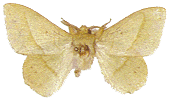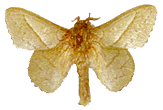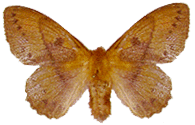|
Trabala
pallida Walker
Amydona pallida Walker, 1855, List Specimens lepid. Insects Colln Br.
Mus.,
6: 1417.
Trabala pallida Walker; Roepke, 1951: 112; Holloway, 1976: 90.

Trabala pallida pallida ♂
(natural
size) |

Trabala pallida montana ♂
(natural
size) |

Trabala pallida montana ♀
(natural
size) |
Diagnosis. In the male the forewings are perhaps more angular than in
other species, the postmedial fasciae oblique, straight, grading away
distad rather more than in other species. The submarginal spots are joined
as a fine line on the hindwing and more continuous than in most species on
the forewings. The female has strong, dark fasciae, a prominent discal
spot, and diffuse brownish patches on the dorsum of the forewing and often
the hindwing. A freshly reared female is illustrated. The male genitalia
have a pair of processes on the tegumen, each of a single spine with a
serrate lobe just distal to it.
Taxonomic notes. The overlap with altitude of the typical race with
ssp.
montana Roepke throughout the Sundanian range of the species suggests that
the latter must be regarded as only a form of pallida if the two taxa are
conspecific. More research is needed on this question.
Geographical range. Sundaland, S.E. China.
Habitat preference. The species ranges from the lowlands to 2000m,
represented mostly by f. montana at higher altitudes.
Biology. Roepke described and illustrated the larva. It has a
conspicuous yellowish or whitish dorsal streak, with, more laterally,
segmental blue tubercles. Otherwise the body is variegated white, grey and
brown, invested with hairs, though less densely than in vishnou.
The larvae can be found exposed, lying longitudinally on leaves of the
host-plant (e.g. Melastoma) during the day (as above). Pupation is
in a densely matted golden brown cocoon, two-humped like a camel's back,
attached to a twig of the host-plant.
The host-plants recorded have been Lagerstroemia, Melastoma, Persea,
Psidium, Punica, Schleichera and Terminalia.
<<Back
>>Forward <<Return
to Contents page
|

